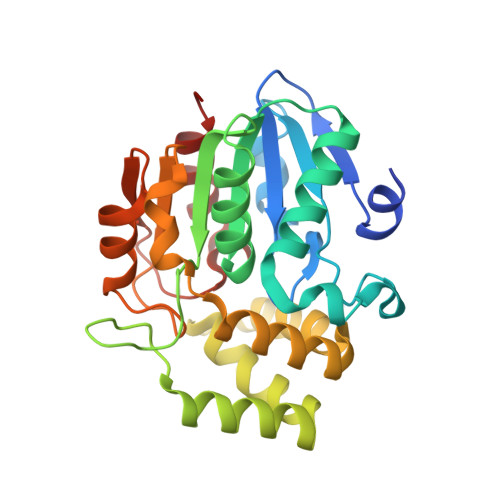Triazole Ureas Covalently Bind to Strigolactone Receptor and Antagonize Strigolactone Responses.
Nakamura, H., Hirabayashi, K., Miyakawa, T., Kikuzato, K., Hu, W., Xu, Y., Jiang, K., Takahashi, I., Niiyama, R., Dohmae, N., Tanokura, M., Asami, T.(2019) Mol Plant 12: 44-58
- PubMed: 30391752
- DOI: https://doi.org/10.1016/j.molp.2018.10.006
- Primary Citation of Related Structures:
5ZHR, 5ZHS, 5ZHT - PubMed Abstract:
Strigolactones, a class of plant hormones with multiple functions, mediate plant-plant and plant-microorganism communications in the rhizosphere. In this study, we developed potent strigolactone antagonists, which covalently bind to the strigolactone receptor D14, by preparing an array of triazole urea compounds. Using yeast two-hybrid and rice-tillering assays, we identified a triazole urea compound KK094 as a potent inhibitor of strigolactone receptors. Liquid chromatography-tandem mass spectrometry analysis and X-ray crystallography revealed that KK094 was hydrolyzed by D14, and that a reaction product of this degradation covalently binds to the Ser residue of the catalytic triad of D14. Furthermore, we identified two triazole urea compounds KK052 and KK073, whose effects on D14-D53/D14-SLR1 complex formation were opposite due to the absence (KK052) or presence (KK073) of a trifluoromethyl group on their phenyl ring. These results demonstrate that triazole urea compounds are potentially powerful tools for agricultural application and may be useful for the elucidation of the complicated mechanism underlying strigolactone perception.
Organizational Affiliation:
Graduate School of Agricultural and Life Sciences, The University of Tokyo, 1-1-1 Yayoi, Bunkyo-ku, Tokyo 113-8657, Japan.















